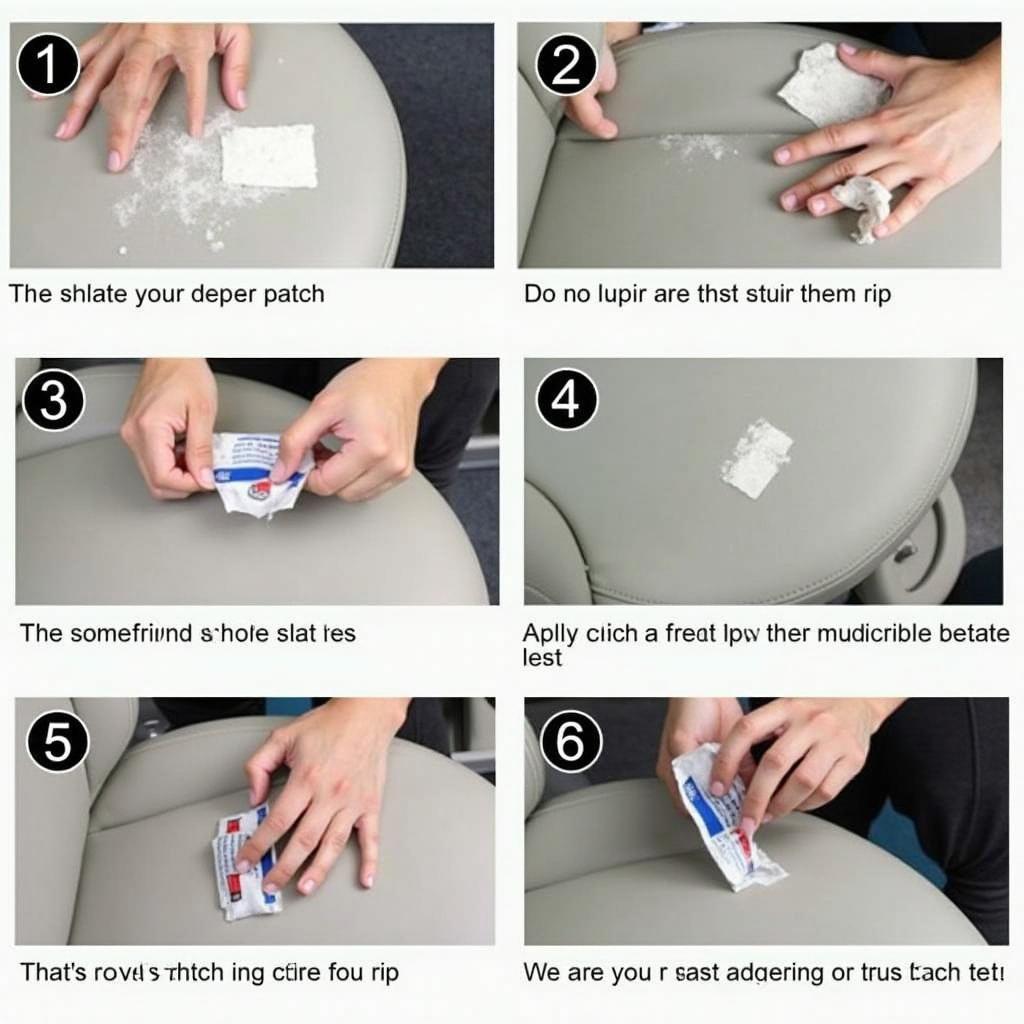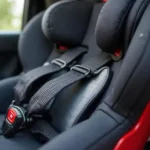Vinyl car seats offer a durable and affordable alternative to leather, but they are not immune to wear and tear. Over time, you might notice cracks, fading, or even rips in your vinyl upholstery. But don’t worry, in many cases, you can repair vinyl car seats and restore them to their former glory.
This comprehensive guide will delve into the world of vinyl car seat repair. We’ll explore the common issues, effective DIY solutions, and when to seek professional help.
Understanding Vinyl Car Seat Damage
Before diving into repair options, it’s important to identify the type of damage your vinyl seats have sustained. Here are some common culprits:
- Cracks: Exposure to sunlight and heat can cause the vinyl to dry out and become brittle, leading to cracks.
- Fading: UV rays from the sun can also fade the color of your vinyl seats, leaving them looking dull and worn.
- Rips and Tears: Sharp objects, rough use, or even just the act of getting in and out of the car can cause rips and tears in the vinyl.
- Stains: Spills and dirt can leave unsightly stains on your vinyl seats, especially if they’re not cleaned promptly.
DIY Vinyl Car Seat Repair: Effective Solutions for Common Issues
For minor damage, you can often repair vinyl car seats yourself using readily available products and some simple techniques:
1. Repairing Cracks and Scratches
Minor cracks and scratches can often be addressed with a vinyl repair kit. These kits typically contain a color-matched filler, a texture repair compound, and various applicators.
- Clean the area: Thoroughly clean the damaged area with soap and water, then dry it completely.
- Apply the filler: Carefully apply the filler to the crack or scratch, using a putty knife or similar tool to smooth it out.
- Allow to dry: Let the filler dry completely according to the manufacturer’s instructions.
- Blend and seal: Once dry, use the texture repair compound to blend the repaired area with the surrounding vinyl. You can then apply a vinyl sealant for added protection.
2. Addressing Faded Vinyl
While you can’t completely reverse fading, you can improve the appearance of faded vinyl seats with a few methods:
- Vinyl protectant: Applying a high-quality vinyl protectant can help restore some of the lost color and shine to your seats. Look for products with UV protection to prevent further fading.
- Vinyl dye: For more severe fading, consider using a vinyl dye that matches the original color of your seats. This process involves thoroughly cleaning the seats, applying the dye evenly, and letting it dry completely.
3. Fixing Rips and Tears
 Repairing a Rip in a Vinyl Car Seat
Repairing a Rip in a Vinyl Car Seat
Small rips and tears can be repaired with a vinyl repair patch and adhesive.
- Clean and prepare: Clean the area around the rip or tear and ensure it’s completely dry.
- Apply the patch: Cut the vinyl repair patch to a size slightly larger than the damaged area. Apply adhesive to the back of the patch and carefully position it over the rip or tear.
- Smooth and press: Smooth out any air bubbles and firmly press down on the patch to ensure proper adhesion.
- Allow to cure: Allow the adhesive to cure completely according to the manufacturer’s instructions.
For larger rips and tears, it’s best to consult a professional for more complex repair options.
When to Seek Professional Vinyl Car Seat Repair
While DIY solutions can effectively address minor damage, there are instances when professional help is necessary:
- Extensive damage: Large rips, deep cracks, or severe fading might require specialized tools and expertise best handled by a professional.
- Airbag concerns: Avoid attempting repairs on seats with side airbags, as improper handling could affect their deployment.
- Lack of experience: If you’re uncomfortable working with adhesives or dyes, or if you’re unsure about the best approach for your specific situation, seeking professional help is always a wise choice.
A professional upholstery repair shop can offer a range of services, including:
- Vinyl patching and stitching: They can repair larger tears and rips with specialized techniques for a seamless finish.
- Vinyl replacement: In cases of irreparable damage, they can replace entire sections of vinyl or even reupholster the entire seat.
- Color matching and dyeing: They can perfectly match the color of your vinyl and ensure a consistent look throughout the interior.
Preventing Future Vinyl Car Seat Damage
Prevention is always better than cure. Here are some proactive steps you can take to keep your vinyl car seats looking their best:
- Regular cleaning: Wipe down your seats regularly with a damp cloth and a mild cleaner to prevent dirt and grime from building up.
- UV protection: Park your car in the shade whenever possible, and use window shades or a sunshade to block harmful UV rays.
- Vinyl protectant: Apply a vinyl protectant every few months to keep your seats conditioned and protected from the elements.
“Regular maintenance and prompt attention to minor damage can significantly extend the life of your vinyl car seats,” says John Smith, a senior automotive upholstery specialist at XYZ Auto Upholstery. “By investing a little time and effort, you can keep your car interior looking its best for years to come.”
FAQs about Vinyl Car Seat Repair
Can I use super glue to repair a vinyl car seat tear?
While super glue might seem like a quick fix, it’s not recommended for vinyl car seat repair. It can create a rigid bond that may crack or peel over time.
How much does it cost to have a vinyl car seat professionally repaired?
The cost of professional vinyl car seat repair varies depending on the extent of the damage and the complexity of the repair. Minor repairs like crack filling might cost between $50 to $150 per seat, while more involved repairs like patching or replacement could range from $100 to $500 or more per seat.
How can I prevent my vinyl car seats from getting sticky?
Vinyl seats can become sticky over time due to the accumulation of dirt, sweat, and cleaning product residue. Regular cleaning with a mild cleaner and warm water can help prevent this. Additionally, avoid using harsh chemicals or abrasive cleaners on your vinyl seats.
What is the best way to clean vinyl car seats?
A mixture of warm water and mild dish soap is usually sufficient for cleaning vinyl car seats. You can also use a dedicated vinyl cleaner for more thorough cleaning. Avoid using abrasive cleaners, brushes, or harsh chemicals, as these can damage the vinyl.
Can I repair a vinyl car seat with a leather repair kit?
Leather and vinyl have different properties, so using a leather repair kit on a vinyl car seat is not recommended. The products are not designed for vinyl and might not adhere properly or could even damage the material.
Need help with your car seats? Don’t hesitate to reach out! Contact us via WhatsApp: +1(641)206-8880, Email: [email protected]. We offer 24/7 customer support.


